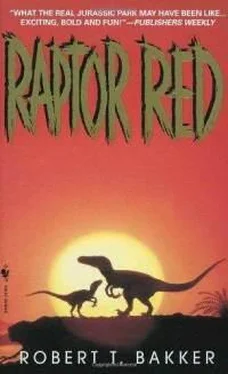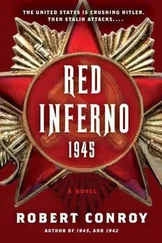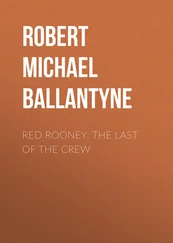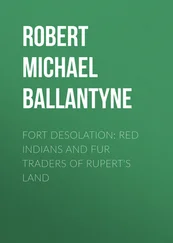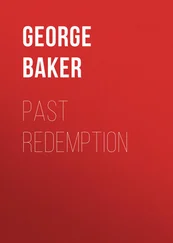His light has gone out.
His eyes have a dull, constant stare. He looks but doesn’t focus on anything. He doesn’t react to the other defeated bulls.
Inside his small gaston brain, this male has given up. Too many spring ramming-contests. Too many seasons with his body pumped up with hormones. This is the third year he’s left the mating grounds without a female consort, and his biological clock has wound down - he’s genetically superfluous. The genes that run his behavior don’t provide specific orders for an elderly loser. Why bother? Even if he tries his best, his chances of fathering offspring next year are too low.
The young male raptor moves cautiously through the thicket, following the tired bull. Raptor Red and her sister follow.
The bull plods through a pool of muddy water and lies down. The warm water feels good. He rolls halfway onto his left side, then to his right, letting the mud ooze into countless bruises.
The male raptor starts to twitch in anticipation.
The bull drags his body into the deeper part of the wallow. He rolls onto his left side and closes his eyes, his body two-thirds submerged. His brain is lulled into a stupor by the warm, soothing bath.
The male raptor moves swiftly, quietly. He strikes with his hindfeet at the exposed gaston underside. Raptor Red strikes immediately after.
The bull howls. His legs flex helplessly. But the raptor attack pushes him onto his back. Raptor Red’s sister jumps onto his belly and rips him open. The older chick joins her mother, attacking with adult-style ferocity.
The bull gaston’s mind succumbs to the attack before his body does. He’s aware of his own death, but in the final moments he is free of pain and fear.
The raptor pack feeds on the bull for three hours, ignored by the other gastons, who feel no loss at his death. Raptor Red’s sister eats with noisy satisfaction - this is the first time she’s had Gastonia bull, and she finds its texture and taste quite satisfying. She bumps and nuzzles Raptor Red in gestures of victory and appreciation. She nuzzles her oldest chick too, in celebration of her taking on the mature role of killer.
Raptor Red’s sister is in a rare good mood. But she still won’t look at the young male and she won’t acknowledge his headbobbing. He tries to bump her snout with his, but she answers with a curled-lip snarl, and he backs away and sits by himself. Raptor Red looks back and forth, from her sister to her male consort. Then she gives him an especially long, affectionate muzzle-nuzzle.
When night falls, the well-fed chicks find their usual sleeping places, side by side next to their mother. Raptor Red pushes open a space between a chick and her sister with her right foot and lowers herself down. She closes her eyes.
Something isn’t right, and she snaps her eyelids open. The male is still standing up, looking around awkwardly, sniffing in the direction of the raptor sisters. He shuffles off to a pile of dry brush and starts to scrape a temporary nest together with his hindclaws. Raptor Red notices that he is very unskillful at this activity.
Raptor Red sits up. It’s warm and comforting, being wedged among her blood relatives. Still, she has a churning feeling in her head and it gets worse as she watches the male’s pitiful attempts to construct his nest.
She extends her knees and ankle joints, rising above her snoring kin, and steps out of the sleeping group. The hole she leaves among the somnolent bodies is immediately filled by a chick leaning to its left and her sister leaning to her right.
Raptor Red walks over to the male and knocks him in the flank with her snout. Then she gathers fallen branches with vigorous sweepings of her hands and feet. There aren’t enough, so she reaches up with her jaws and breaks down some fresh branches from the trees.
When the nest is big enough for two, she sits. The male stares for a minute, walks slowly over to her and lowers his body with great care, leaving a foot of space between their torsos.
Raptor Red sighs and leans toward him. As she drifts off to sleep, she can feel him just barely begin to apply his own body pressure back toward her.
FAMINE AND THE WING SHADOW
AUGUST
It’s the time of summer drought. Streams fail, and the ponds dry up into dead layers of sun-hardened mud. The herds of plant-eaters flee the lowlands, and the predators who remain must squabble over a dwindling supply of meat. And it’s the time when famine pulls apart the social bonds of Utahraptor packs. The carnivore parents become lax in watching where their youngsters wander off to.
The alpha male deinonych can’t believe his good fortune. There, within easy striking distance, is a Utahraptor chick, wandering alone, without an adult in sight. The deinonych holds his 130-pound body as low as he can and chirps a hurry up! message to his two brothers.
We can kill that chick - before its parents know we’re here, he thinks. He’s hungry. But he’d try to kill the chick even if he were well fed. Predator species have spite hardwired into their behavior. Killing the competition before it’s grown up is always a good ecological strategy for meat-eaters.
The little Utahraptor chick has wandered off from its pack for the first time in its life. There’s no food back at the temporary nest the adults have built, and the baby raptor is sniffing at holes where the multis hide, the roly-poly furballs shaped like wood-chucks.
'Chck-chck-chck… chck. ' The chick runs to a hole where a plump multi is making its alarm call.
Fwwoop! The multi disappears down its burrow as if it were sucked by a vacuum.
Chck-chck-chck-chck-CHCK! Another multi twenty feet away makes a loud protestation at the chick’s presence. The foolish little Utahraptor turns and runs at him.
Just as the chick reaches his burrow, the multi ducks underground, and a third furball starts clicking his lungs out ten yards in the other direction.
Stupid chick - this will be easy, the deinonych leader thinks as he watches the little raptor get dizzy running back and forth across the multi colony.
The alpha deinonych crawls along a dry arroyo till he’s at the edge of the colony. With every zigzag maneuver, the chick gets closer and closer to the hidden predators. The furballs are so busy playing the decoy game with the chick that they don’t notice the deinonychs.
But up at three hundred feet, a very alert set of eyes has been watching. A huge white dactyl has been making silent spirals down from a thousand-foot altitude. He banks steeply to his left and makes a low-angle pass at the multi colony.
Dust clouds erupt in the overgrazed soil between the multi burrows. The dactyl’s immense white wings stir up a tornado of dried multi droppings and plant bits, and the swirling maelstrom of dirt and dung blinds the deinonychs. The Utahraptor chick falls over, gets up, runs back toward its nest, trips in a multi hole, gets up again, and is gone from view before the dust settles and the deinonychs can see what has happened.
To the deinonychs and the Utahraptor, the situation is life or death. To the dactyl, it’s a game.
The dactyl climbs to five hundred feet to survey the scene he’s created. He likes intervening in the lives of predators - it amuses him. He’s spent all his waking hours amusing himself, ever since that day in the spring when he decided he would not take a mate.
The great white dactyl is a very special case. He’s sixty years old, healthy, fit, his senses keen. He’s observed many generations of raptors in their struggles to raise families. He’s helped raise dozens of broods of his own species, with the help of five mates, all now dead.
Dactyls live longer than dinosaurs - a general advantage of life on the wing. If it survives the dangers of youth, a young adult dactyl can look forward to thirty or forty years, average lifespan. This particular dactyl is an old-timer even by pterodactyl standards. And he has decided this year that he has had enough. He will never breed again. He’s a biological oddity - a widower who is content.
Читать дальше
